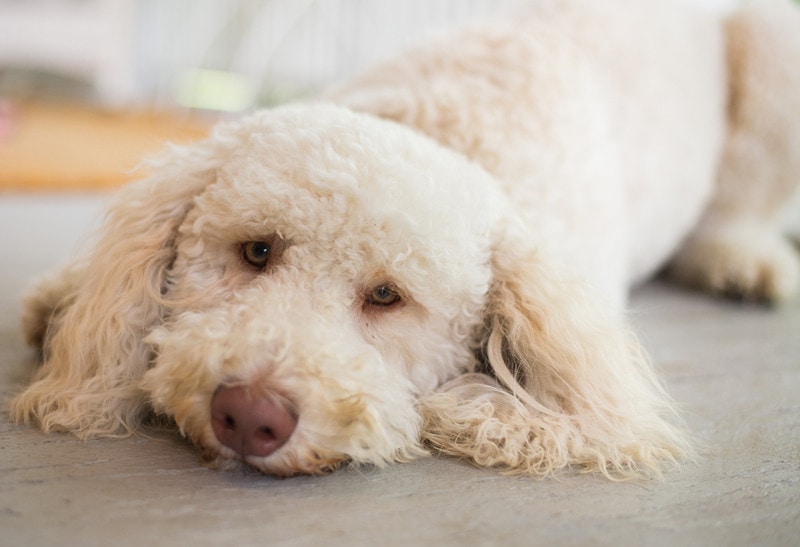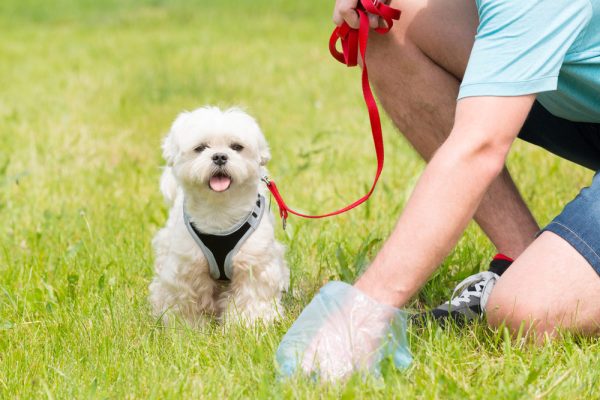In this article
View 3 More +Adopting a new dog is always fun and exciting, but it also means taking the time to learn more about your new companion. In the case of female dogs, this includes knowing when yours will go into heat. The age a dog goes into heat won’t always be the same for different breeds or sizes, so you need to figure out when, on average, your dog breed will experience one so you’re prepared. Generally speaking, the smaller the dog, the earlier they will come into heat for the first time.
If you have a Labradoodle, you can expect your dog’s first heat to happen between 6 and 9 months of age (although some dogs don’t have a first heat until between 12 and 14 months). What can you expect when this occurs? Keep reading to find out!

A Labradoodle’s Heat Cycle Explained
What exactly is a heat cycle? Well, heat is the phase of the reproductive cycle sometimes referred to as “in season.” The first part of this phase is when a female dog has external signs of hormonal changes and attracts males, while in the second and main part of heat, the bitch is fertile, receptive, and able to get pregnant.
The heat cycle consists of four phases called proestrus, estrus, metestrus, and anestrus, which occur one after the other. Proestrus and estrus encompass the period of heat. How long the entire cycle lasts varies by dog; most bitches have two cycles per year.
For a Labradoodle, the first heat usually occurs around 6 to 9 months. Heats typically happen twice a year and last 2 to 4 weeks on average. Of course, the length of the heat period can vary by canine—your pet’s heat may only last 10 days or end up being 5 weeks long.

What Occurs When a Labradoodle Is in Heat?
A dog’s heat happens during the part of the female reproductive cycle known as proestrus and estrus, when eggs are produced that are ready for fertilization. When a heat hits, your Labradoodle will show behavioral and physical changes that indicate what’s happening. Some of the signs your Labradoodle can experience during heat include:
- The vulva will appear swollen.
- Bloody discharge from the vulva will likely appear.
- Your dog may be more affectionate than normal or could go the other way and be more distant than is typical.
- Your dog will attract male dogs.
- There may be more licking of the genitals.
- During the first days your dog will reject males.
- Afterwards, your dog will show interest in males and will lay down to allow mating.
- Your pet may lack energy.
Caring for a Labradoodle in Heat
The most important thing to remember when caring for a Labradoodle in heat is that if you aren’t looking to have puppies, you must keep your Labradoodle away from male dogs! Other than keeping your pet separate from males during this time, keep feeding your dog their regular diet along with lots of fresh water. Also, ensure your Labradoodle continues getting enough daily exercise, so you can help ease stress.
One other note on caring for a Labradoodle that has not been spayed—there is a serious medical condition known as pyometra, or uterine infection, that can occur approximately 2 to 4 months after heat, typically in older bitches. It can occur due to hormonal and bacterial factors and is something to keep an eye on in non-spayed dogs.
Pyometra is potentially life threatening and is always a medical emergency. In “open” pyometra, you will notice pus or bloody discharge from your dog’s vulva; however, if “closed” pyometra occurs, there will be no discharge present, and your dog may just show reduced appetite, lethargy, pain in the abdomen, increased thirst, increased urination, and diarrhea. You should contact your vet immediately if you suspect your dog may have pyometra.
If you need to speak with a vet but can't get to one, head over to PangoVet. It's our online service where you can talk to a vet online and get the advice you need for your dog — all at an affordable price!

The Importance of Spaying
There are many benefits to having your dog spayed other than avoiding pregnancy. There are also a few risks, but the benefits far outweigh them. Take a look below to find out both!
- Less risk of mammary (breast), ovarian, and uterine cancers
- Less risk of pyometra
- Less risk of sexually transmitted diseases (STDs)
- Not contributing to canine overpopulation
- Eliminating heat cycles and all the medical conditions related to them, like false pregnancy
- Problems with anesthesia (more likely to happen in dogs with underlying medical issues or older canines)
- Complications such as hemorrhage
- Inflammation or infection of the surgical wound
- Surgical incision reopening
The good news about these risks is that there’s only a small chance of them happening. You can also avoid some of these risks by keeping your dog from licking or chewing at the incision site after surgery. If you have any worries about spaying your Labradoodle, though, speak to your vet about the process so you can make an informed decision. Your vet will be able to explain the different techniques that can be used, traditional and laparoscopic spay, so you can learn more.


Conclusion
Female Labradoodles typically go into their first heat between 6 and 9 months of age, though some do not until between 12 and 14 months. A Labradoodle’s heat usually lasts around 2 to 4 weeks and happens twice a year. You’ll be able to tell if your Labradoodle is in heat when they begin experiencing physical and behavioral changes.
You can avoid your Labradoodle going into heat, though, by having your pet spayed. This prevents unwanted pregnancy and reduces the risk of several diseases occurring later! Speak to your vet about when it is best to have your dog spayed.
Featured Image Credit: Olena Yakobchuk, Shutterstock



















